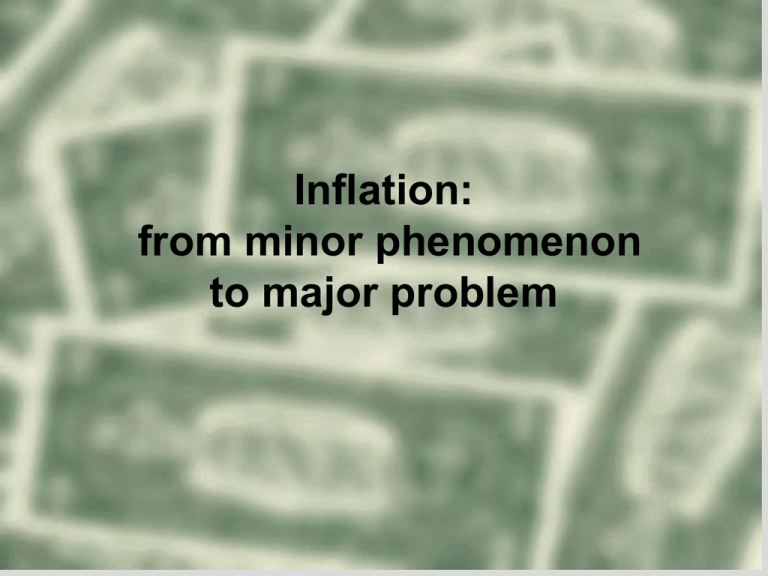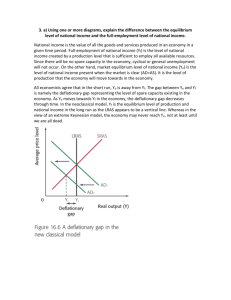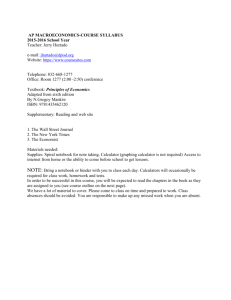Inflation and the Crisis of Keynesian Theory
advertisement

Inflation: from minor phenomenon to major problem Inflation & Keynes $ In the Keynesian model, inflation is only implicit, the aggregate price level does not appear explicitly in any of the models we have been looking at $ There CAN be an "inflationary gap", or a "deflationary gap" $ These are defined vis a vis the "full employment level of output" Full Employment Output $ The definition of "full employment output" is vague $ Most people think about this in technical terms about what "can be" produced with the given capital stock & labor $ But clearly this is flexible. Capacity can be squeezed, but this puts upward pressure on prices as business has to pay more for factors of production Gaps $ Suppose Yfe is the full employment equilibrium level of output C, I, G aggregate demand deflationary gap inflationary gap B Y A Y Inflationary Gap $ The notion is that if planned aggregate demand exceeds full employment output there will be upward pressure on prices (demand pull inflation) aggregate demand C, I, G deflationary gap inflationary gap B Y A Y Deflationary Gap $ If aggregate demand is less than the full employment output there will be downward pressure on prices (prices reduced to sell) C, I, G aggregate demand deflationary gap inflationary gap B Y A Y Gaps & Policy $ Clearly, the presence of an inflationary gap or a deflationary gap suggests policy responses: $ Inflationary Gap: use monetary & fiscal policy to reduce aggregate demand $ Deflationary Gap: use monetary & fiscal policy to increase aggregate demand (as in the Great Depression) Philips Curve $ With inflation determination only implicit and no direct way to determine the degree of inflationary or deflationary pressure in the models we have been looking at, Keynesians discussed some of the problems using a separate theoretical construct: $ The so-called Philips Curve which was not really the curve developed by Philips Philips' Own Curve - I $ Philips analysed the trade-offs between unemployment and wage increases over the course of the business cycle $ As the cycle swung up and unemployment dropped, tightening the labor market, wages tended to rise ever faster $ As the cycle dropped into bust and unemployment rose, wage increases dropped and eventually wages fell. Philips' Own Curve - II $ Studying empirical data Philips discovered that these changes followed a pattern: w/W U Keynesian Philips Curve $ The Keynesians shifted focus from wage changes (w/w) to price changes (p/p) and substituted a curve for a loop: p/p U Late 60s & Trade-offs $ This Keynesian Philips curve became popular in late 1960s as wage growth began to outstrip productivity growth and inflation accelerated. $ The emphasis was on the trade-off btwn unemployment & inflation to get less unemployment you had to accept higher inflation to get less inflation you had to tolerate higher unemployment The Data $ Between 1961 & 1969 actual data fit the Philips curve very well: 1969 p/p 1961 U Keynesian Antidote $ But by 1969 after almost a decade of accelerating inflation, enough was enough $ So, in 1970 Keynesian policies were used to precipitate a recession, which, according to the Philips curve would result in less inflation and more unemployment $ Inflation/unemployment should slide back down the curve. It did not. Crisis $ The 1970 recession dramatically raised unemployment but inflation barely wavered: 1969 1970 p/p 1961 U Crises $ First crisis: 1970 Keynesian recession fails to lower wage pressure & inflation $ Second crisis: 1971 Abandonment of Bretton Woods signals failure $ Third crisis: 1974-75 recession repeats experience of 1970: higher unemployment no substantial reduction in inflation Responses $ Theoretical reconstruct macro models to put inflation up front and at the center of attention aggregate supply & demand (treat macro like micro) revival of monetarism $ Pactical shift to floating exchange rates use inflation against real wages use inflation to redistribute income from labor to capital eventually full-scale attack on wages via depression --END--







